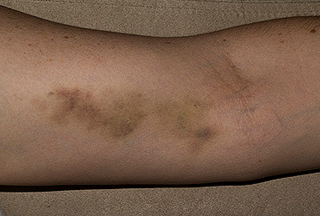
A bruise, which is also known as a contusion, is essentially a blood clot, often caused by a bump, knock or fall. When the skin gets knocked, the capillaries are damaged and blood seeps into the tissue around them.
Symptoms of Bruises
A fresh bruise often feels tender, painful and has a reddish appearance but after a few hours it will start to change colour. Swelling can sometimes occur alongside a bruise. The pain should only last up to two days; if a customer is still suffering from pain after this time then they should seek medical advice to ensure there is no internal damage.
There is a particular type of bruise which requires immediate referral to the pharmacist; haematomas are severe bruises that are caused by the leaking of blood in to the tissue after the rupture of a large blood vessel. A haematoma causes extensive and rapid swelling; for example in the calf muscle the swelling can be as large as a melon within a few hours after the injury. Severe bruising, pain and swelling following a sporting injury should be referred to the pharmacist for assessment.
Colour scale for bruises
There are five stages to a bruise. A fresh bruise is usually bluish purple, after a day or two it will turn blue. The bruise will turn brown to green then yellow and finally back to the normal skin colour as it heals. As a bruise heals enzymes break down the blood into different components and it is this that causes the bruise to change colour over time.

There is no risk of infection with a bruise, unlike cuts and grazes, as the skin has not been broken. It is important to be aware however that a bruise can be symptomatic of an internal infection for example septicaemia or blood poisoning therefore if the bruising starts to spread rapidly or cannot be attributed to a specific knock or trauma then immediate medical advice
Causes of Bruises
Bruises are often caused by a mild trauma but they can occur due to small tears in the blood vessels just underneath the skin; this can often be caused by rigorous exercise and is very common in athletes.
The size and shape of the bruise will depend on a number of factors:
- Age – as we age the skin becomes thinner and less elastic therefore can bruise more easily.
- Gender – bruising is more common in women; their skin is thinner and the blood vessels and fat cells are organised differently.
- Colour of skin – bruises can be more prominent in lighter complexions.
- Disease – certain diseases such as leukaemia and coagulation disorders can make people more prone to bruising.
- Medication – patients taking medicines like warfarin and aspirin are likely to bruise more easily.
- Location – certain areas of the body contain more blood vessels which can impact on the severity of the bruise.
Treatment for Bruises
Most bruises will not require treatment however for more severe bruising they can be treated at home by using the RICE technique:
- Rest – which helps to prevent further injury and prevent internal bleeding.
- Ice – it is particularly important to apply an ice pack immediately as it cools the affected area and helps to limit the blood flow which aids recovery. Never use ice on broken skin.
- Compression – a warm compress used a few days after bruising can speed recovery.
- Elevation – reduces the blood flow to the affected area to help reduce the swelling.
You can recommend that a few days after injury a heat pack can be applied to the affected area which will dilate the blood vessels and help circulation. Never apply ice or heat packs directly to the skin as this can cause burns; packs should be wrapped in a towel.
Painkillers such as paracetamol and ibuprofen can be recommended for the pain. There are a number of other treatments that can be used to reduce the swelling and appearance of a bruise.
Natural ingredients such as arnica which are found in topical gels and creams have long been used to treat bruising.
It is also known that gentle massage combined with heat can stimulate the blood flow which can help to relieve pain but it is not recommended that a bruised area is massaged for the first three days after the injury occurred.
